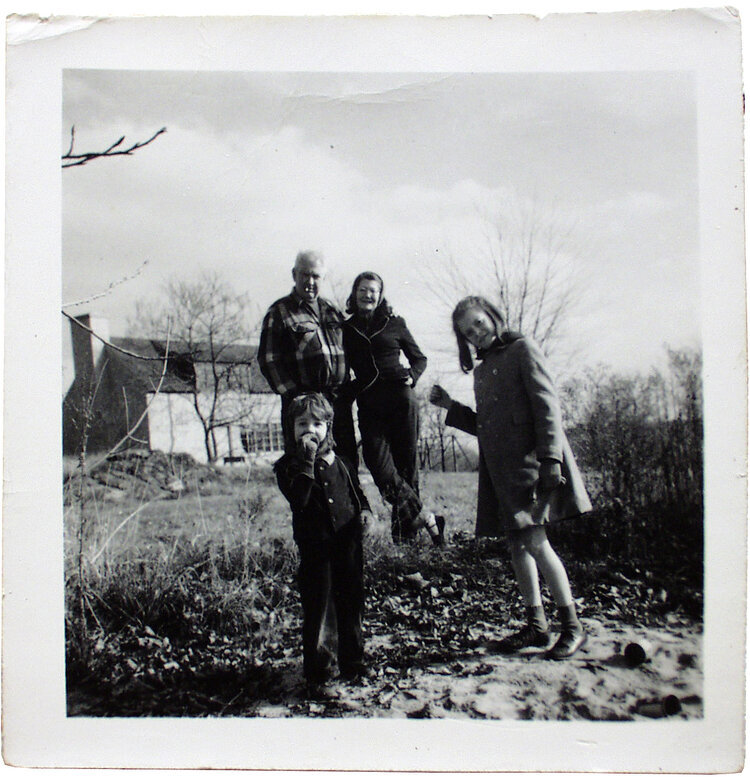Remembering Alexander calder
Calder was a powerful inspiration to me. His playful kinetic art influenced me at a very young age.
This is a photo of the first time I met Alexander Calder. It was in Roxbury, Connecticut when I was around 4 years old. On this photo that my father Jacques took, you can see my mother Zabeth who was leaning against Calder, my sister Eva and myself. I remember being left alone in a room with a box of toys that Calder made. These whimsical and out of the ordinary toys filled me with wonder!
Calder, who everyone called “Sandy” was a close friend of my Uncle Jean Davidson. He moved next door to where my family lived in the Loire Valley in France. My Uncle Jean married Calder’s daughter, Sandra, and they lived in a converted mill near by. While Calder’s home, François Premier, was being renovated, he and his wife, Louisa, stayed at Becheron, our family home.
I found Calder’s home to be quite fascinating. Whereas, my parents lived in a more classic environment of antiques and figurative sculptures by my grandfather Jo Davidson, Calder’s house had a more rustic and decidedly contemporary feel. There were modern abstract paintings by his friend Miró and other contemporary painters, colorful Japanese kites hanging among his Mobiles and his home-made lamp shades made from cake molds. All this was a world of fascinating curiosities to me.
This is a photo of Calder getting his hair cut by his wife, Louisa, in the courtyard of our home.
Another photo during that time when they were living at our home. From right to left are Calder, my mother Zabeth, Sandra Calder and a friend.
These photos were taken by my father, Jacques Davidson, at our Becheron home in Saché, France.
When I was around 12 years old, I spent an afternoon with Calder in his studio, watching him and playing with scraps of the aluminum he used. To this day, I recall the experience vividly. The barn that served as his studio had a large expanse of glass facing west. The workbench was overcome with tools of all kinds and sizes, metal scrapings, all sorts of pliers, files, saws, drills, shears that he had retrofitted with spring wire so that they would open up by themselves. There was artwork everywhere, some waiting to be finished, most already painted hanging from the ceiling, some strewn about on the ground and in the corners... everywhere.
I remember watching him cutting out this very neat shape with these enormous (to my young eyes at least) shears. I loved that shape, the lines were very neat and the sharp points gave the shape a dynamic appeal. He then switched to his files and continued to refine the shape he had just carved out. He then proceeded to cut off the sharp points and rounded them with his file. When I asked why he was doing this (disappointed that in my view he had just ruined the shape) he explained that you had to soften the edges of the shapes so that people would not hurt themselves with the points or the edges. When it was time to leave, I asked if I could take home some of the scrap aluminum that was on the floor and he said to go right ahead and take some.
That evening, I took those metal scraps to my father’s workshop. I readily decided to try making one of those nifty things called Mobiles. Of course, I did not have at my disposal the tools and the full set of materials, but try, I did. I failed miserably! The metal was too thick for my father's over-worn and dull shears. Most of all, I had not watched the process quite attentively enough. Where a mobile is constructed from the bottom up, my project was attempted from the top down. As I soon found out, whenever you add something, you have to correct every preceding balancing point. A few days later, when I shared my frustration with Calder, I was set straight. He said that you must start from the bottom! Eventually, I was able to secure a couple of spools of recycled chicken wire that had all sorts of kinks and required a lot of massaging to straighten out. Later, I was enlightened to the fact that Mobiles are made with piano wire also called music wire which has spring quality and retains its given shape very well. Instead of the thicker gauges that Calder used, I used aluminum coffee cans which were much thinner and easier to cut with my blunt old shears. My sister Eva still has one of the first Mobiles I made at the time, the wire was hardly straight, the shapes are all bumpy and irregular, but it has movement and some dynamics.
Once I understood how to make them, I started making Mobiles for my family and friends. I even got to trade one with Max Ernst, a family friend, for one of his posters. Calder once told my mother that I had understood the linking and attachments well. Of course, that is just the rudiments of Mobile making, but it was a start. The afternoon of my fifteenth birthday, Calder handed me a very special gift, a pair of his Sargent pliers that he always had on his person.
These are the pliers that Calder gave me on my 15th birthday.
This is a photo of the Gouache that Calder gave me in 1975. That was the last time I saw him. He died that next year.
His influence on my life was immense.





